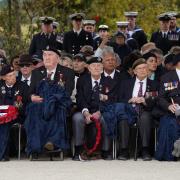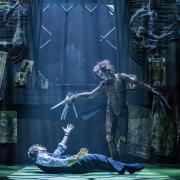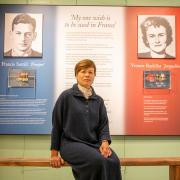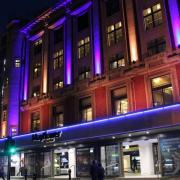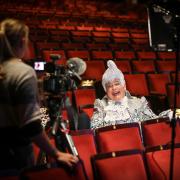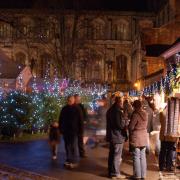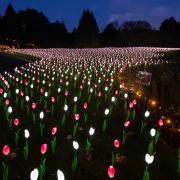1914 and a small corner of Hampshire witnesses the most extraordinary scenes as it’s mobilised to repair the casualties of The Great War. Almost 100 years on, Netley’s Royal Victoria Military Hospital continues to reveal its stories, Viv Micklefield discovers some of them

If the faces staring out from the grainy photographs say a thousand words, then you’d expect to fill volumes with their tales. Yet it’s a paradox of war that there’s so much left untold. Visiting the Royal Victoria Country Park today, the picture is of families out having fun. Turn the clock back to the events surrounding WW1 however, and a very different scene comes into focus.
Armed with the knowledge that I’d be ‘walking in the footsteps’ of tens of thousands of wounded soldiers, removed from the battlefield to one of the largest and most famous hospitals in the British Empire, the first surprise is how little remains. In fact, only the chapel, now a heritage visitor centre, and its distinctive domed bell tower, serves as a reminder of the colossal edifice that once stood imperiously on the banks of Southampton Water. Not long after the outbreak of WW1 this site would have been teeming. In fact, after becoming the army’s first purpose-built receiving hospital during the Crimean campaign, it had already seen the aftermath of several major conflicts. But this was off the scale; the shattered survivors returning from France and Belgium joined by soldiers fighting in Gallipoli and Mesopotamia. According to local historian and author Philip Hoare (Spike Island: The Memory of a Military Hospital pub. Fourth Estate), the impact on the community was huge. “People living in this part of Hampshire would have been much more aware of the true extent of the war than other civilians,” he observes. “During the times of the big campaigns on The Western Front, trains would be arriving with casualties who had the mud and blood still on their uniforms.”
Spotting the remains of the railway’s branch line extension grinning like metal gums at intervals through the tarmac in the chapel car park is a sobering reminder of events here. During its peak an astonishing 1200 of these so-called Netley Ward Cars made the journey from the hospital ships docking in Southampton. Another first being that by this time, the carriages were fitted-out to cater for medical staff too.
While patients disembarked within sight of the Royal Victoria’s doors, many were bound for the newly-erected Red Cross Society’s ‘hut’ hospital that had sprung up on the terrace behind. The original hospital, despite its gargantuan proportions only offered one thousand beds and with its ill-conceived design soon lived-up to Florence Nightingale’s prophecy that it was: “An expensive mistake.”
The huts, long since dismantled together with the later Welsh and Irish hospital additions, provided the desperately needed additional beds. There were also extra kitchens, dining and staff quarters for the multitude of medical and ancillary staff on duty. In fact, so busy did the main thoroughfares become, there’s still a road here that’s known as Piccadilly.
And with the population soon growing to the size of a small town, it would have been commonplace to witness civilian cleaners sweeping the corridors, maintenance workers powering-up the hospital’s electricity station, or farmers delivering produce and hay supplies for the horses. These days, there are still residents living in nearby Netley Abbey and Sholing who can trace their roots to the hospital’s WW1 expansion.
For the casualties admitted – as opposed to those transferred to other hospitals, the treatment received depended on whether you found yourself on a medical, surgical or convalescent ward. Artist Paul Smyth’s nine months of hospitalization are captured in his diaries and canvases. A 2nd Lieutenant in the 17th Manchester Regiment, he’d already been operated on in France, following injury at Paschendale. His entry for 28 November 1917, simply says: “In bed. Painted a watercolour.” The ward scene above with its metal bedsteads and the patients, or ‘blue boys’ in their army issue dress, provides a rare insight for granddaughter Barbara Pearce, who recalls: “He had a very bad scar on the left forearm which was probably nearly blown away but treated with skin grafts at Netley. He never ever talked about how he got it and never complained about any pain.”
Netley’s reputation as a centre for medical training and research had already become established, thanks to breakthroughs such as Sir Amroth Wright’s discovery of an anti-typhoid vaccine. And it found its way into popular fiction too, most notably when Dr Watson talks of being at the Army Medical School in Sherlock Holmes’s A Study in Scarlet. While 20th century visitors might baulk at the sight of burns victims immersed in baths and be perplexed by the sight of ‘skull alley’ – part anatomical, part natural history exposé at the hospital’s main entrance, the advances continued. X-rays and some of the first blood transfusions were conducted here, and a prototype iron lung was, supposedly, introduced.
Elsewhere in the grounds the army’s first asylum, or D-block as it became known, figured in Pathe newsreels. “This was a time before anti-psychotropic drugs,” says Philip Hoare. “We know that they were using hypnosis, which was a radical therapy, and many other types of physical therapy to treat the paralysis that sometimes accompanies shell shock. It was extraordinary.”
Today, this former psychiatric unit and the officers’ mess can be spotted through the trees, however, there’s no public access. So instead, a short woodland walk leads to the cemetery, resting place of Netley’s military and non-military. Beneath splaying cedars the WW1 Commonwealth graves stand in serried rows before The Cross of Sacrifice. Should further evidence be needed of the respect shown to all faiths during life and death: there’s the story of those Indian soldiers who’d lost pugerees during battle, being gifted a parcel of muslin from Queen Alexandra. And it was not uncommon to witness a Hindu funeral pyre; a final journey blessed.
The chance to climb the bell tower is one not to be missed, and standing on the viewing platform beneath the original peal, the former scale of operations here unfolds like a carpet. Looking left and right out over the grassy expanse that once housed the original wards, Francis Mitchell one of the guides, reveals the startling discovery made since their demolition in 1966: “Sometimes during the dry summer months, it’s possible to see the almost ghostly outlines of the hospital’s former walls and doorways,” he says. And descending from these dizzy heights to the chapel’s upper gallery, there’s more. It’s said that, occasionally, as the shadows shift, the ‘presence’ of the dozens of soldiers, nurses and doctors who’d once sat here in the gaslight’s glow is felt.
The excited cries of children, riding aboard the park’s miniature railway, break the ethereal spell. At every turn the Royal Victoria Military Hospital, despite having been pressed back into service for WW2, is a distant echo of its former self. But as Francis says: “This is not just a heap of old bricks.” There’s more to here than first meets the eye.
Did you know?
The site was nicknamed Spike Island after the gorse once growing here, or maybe the spikes that secured the chains of convicts bound for Australia.
Netley in numbers
It took one million bricks and £350,000 to build the 19th century behemoth.
Over 2000 beds became available after the Hutted hospitals were built.
Of the 20,000 patients admitted, 99% survived.
30,000 sick and wounded arrived after the outbreak of the Battle of the Somme (July 1916).
Half of all shell shock victims came here, including the poet Wilfred Owen.
68 German POWs are buried together with 636 Commonwealth soldiers and airmen in the WW1 military cemetery.




